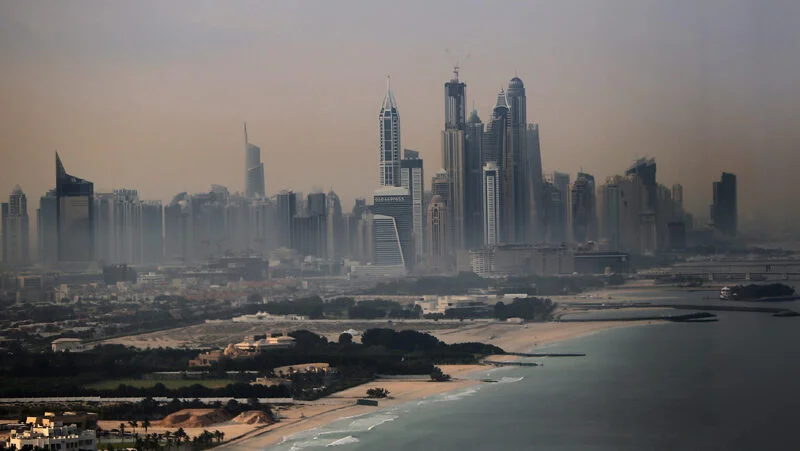Introduction to UAE’s Air Quality
Air quality is one of the most important aspects of daily life, shaping how we breathe, how healthy we feel, and how we interact with the environment around us. In the United Arab Emirates, where rapid growth, bustling traffic, and industrial activity meet desert landscapes and coastal winds, air quality is often a topic of focus. Residents, visitors, and government authorities all pay close attention to pollution levels, as clean air contributes not only to better health but also to the nation’s vision of sustainable living.
The UAE has made air quality monitoring a priority. Across its cities—Dubai, Abu Dhabi, Sharjah, Ras Al Khaimah, Fujairah, Ajman, and Umm Al Quwain—pollution levels are measured daily, and forecasts help people plan their outdoor activities. While challenges remain, the overall efforts towards cleaner skies and greener practices are creating positive outcomes for the country’s future.
Understanding Air Quality Index (AQI)
To understand air quality in the UAE, the Air Quality Index (AQI) is the standard measurement. The AQI shows whether the air is good, moderate, or unhealthy, based on the presence of pollutants like particulate matter (PM2.5 and PM10), nitrogen dioxide, ozone, and carbon monoxide. A lower AQI value represents cleaner air, while higher values indicate pollution that may cause health concerns.

In the UAE, desert dust plays a natural role in influencing AQI, especially during sandstorms. At the same time, human activities such as road traffic, construction projects, and industrial emissions also contribute. Authorities combine advanced monitoring systems with public updates, so that individuals are aware of the day’s conditions.
Current Air Quality in Dubai
Dubai, the most populous city in the UAE, experiences varying air quality throughout the week. In the mornings, traffic congestion can lead to a temporary rise in pollutants, while afternoons often show improved conditions as winds disperse emissions. During weekends, air quality generally improves due to reduced road activity.

Sand and dust from the desert also play a role in Dubai’s air quality. On days with strong winds, dust particles can temporarily lower visibility and increase the AQI. However, Dubai’s coastal location allows sea breezes to push cleaner air into the city, balancing the atmosphere and creating periods of refreshing clarity.
Abu Dhabi’s Air Quality Outlook
As the capital city, Abu Dhabi has focused heavily on air quality management. Its location, with open desert areas and long coastal stretches, means that both natural and human factors influence pollution levels. Traffic, shipping activity, and industrial operations can temporarily affect readings, yet the city’s vast green belts and government measures contribute to improved conditions.
Abu Dhabi’s AQI often reflects moderate levels, with some fluctuations due to weather patterns. Windy days tend to carry away pollutants, creating cleaner skies, while calmer days may allow dust and emissions to linger. Overall, the city’s commitment to monitoring and environmental programs is paving the way toward a healthier atmosphere.
Sharjah and Northern Emirates
Sharjah, Ajman, Ras Al Khaimah, and Umm Al Quwain share similar air quality patterns because of their geographical closeness. These emirates are affected by both urban activities and natural dust. During mornings and evenings, traffic tends to increase pollution levels slightly, but midday breezes often improve conditions.
Ras Al Khaimah and Fujairah, in particular, benefit from their natural landscapes. Fujairah’s eastern coastal winds help push dust away, while Ras Al Khaimah’s mountainous terrain provides fresh air in elevated areas. Weekly monitoring shows that while occasional sandstorms raise AQI levels, these emirates frequently enjoy moderate to good air quality.
Fujairah’s Distinct Climate and Air Quality
Fujairah stands apart from other emirates because of its position facing the Gulf of Oman. The air here often feels fresher and cooler, with sea breezes reducing pollutant concentration. While occasional industrial activity can affect localized areas, the natural influence of the ocean makes Fujairah one of the emirates with more favorable air quality conditions.
Tourists often notice the difference when traveling from Dubai or Sharjah to Fujairah. The clear skies and refreshing atmosphere highlight the importance of natural elements in maintaining balanced air quality.
Factors Affecting UAE Pollution Levels
Pollution in the UAE comes from a combination of natural and human-driven factors.
- Natural dust and sandstorms: These are part of the desert environment and can temporarily lower air quality.
- Traffic emissions: High vehicle usage in major cities increases pollutants during peak hours.
- Construction activities: With rapid development, dust and particles from construction sites contribute to localized pollution.
- Industrial operations: Factories and energy production also play a role, though stricter regulations are steadily reducing emissions.
The balance between these factors determines daily and weekly air quality variations across the emirates.
Government Efforts to Improve Air Quality
The UAE government has placed strong emphasis on sustainability and environmental health. Through advanced monitoring stations, mobile applications, and public reports, residents can stay informed about current AQI levels. Beyond monitoring, long-term projects such as increasing green spaces, promoting electric vehicles, and investing in renewable energy directly contribute to reducing pollution.
Dubai and Abu Dhabi, for example, have introduced initiatives to encourage hybrid and electric cars, while solar energy projects are expanding across the country. These steps not only help reduce emissions but also support the UAE’s vision of becoming a leader in sustainability.
Health and Lifestyle Impact
Air quality directly influences health, and the UAE’s awareness campaigns stress the importance of safe practices. On days when AQI levels are higher, especially during sandstorms, people are advised to limit outdoor activities, wear protective masks if necessary, and stay hydrated.
Children, elderly people, and individuals with respiratory conditions are more sensitive to pollution, making it vital for families to check daily air quality updates. However, the general trend across the UAE shows improving conditions thanks to consistent efforts in managing emissions and pollution.
Technology and Innovation in Monitoring
The UAE is known for embracing technology, and air quality management is no exception. Smart sensors, satellite tracking, and AI-driven data analysis are all used to predict air quality and provide real-time updates. These innovations not only support public awareness but also help authorities take quick action when pollution levels rise.
For example, predictive models allow warnings ahead of sandstorms, giving residents time to prepare. Mobile applications also notify users of hourly changes, making it easier to plan outdoor activities with health in mind.
Community Awareness and Participation
The role of the community is central to improving air quality. When residents choose carpooling, public transport, or eco-friendly products, they reduce their personal contribution to pollution. Schools and organizations across the UAE also engage in awareness programs, teaching children and employees about the importance of sustainability and clean living.
This culture of shared responsibility is becoming stronger, as more people recognize the connection between individual choices and the air they breathe daily.

The Future of Clean Air in UAE
Looking forward, the UAE has ambitious goals for improving air quality. Its Vision 2030 and other national strategies include targets for reducing emissions, expanding green energy, and ensuring sustainable development. These commitments align with the country’s position as a global hub, where health, innovation, and the environment must work hand in hand.
With cleaner technologies, greener cities, and ongoing awareness, the UAE is on a positive path toward a future where pollution levels remain low and air quality consistently supports healthy living. The combination of government policies, technological advancements, and community participation forms the foundation for this brighter future.
Conclusion
Air quality and pollution levels in the UAE reflect a balance between natural desert conditions and human activity. While challenges like sandstorms and traffic emissions remain, the country’s ongoing efforts show remarkable progress. Cities like Dubai and Abu Dhabi are leading with sustainable initiatives, while northern emirates benefit from natural breezes and landscapes that refresh the air.
The overall picture is one of optimism. With continuous monitoring, active government policies, and growing community awareness, the UAE is steadily moving toward cleaner skies and healthier living. The commitment to sustainability not only enhances the environment but also strengthens the nation’s reputation as a place where modern progress and natural wellbeing go hand in hand.
Do follow UAE Stories on Instagram
Read Next – Ras Al Khaimah Real Estate Surge Hits $3.56B; UAE Leads Business Safety














